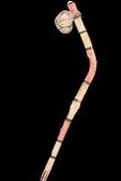Rabbit throwing sticks were used in a holy way by the Hopi tribe:
The traditional land of the Hopi tribe is located in the north-east
part of Arizona in a region called Tusayan, where the ruins of their
villages called pueblos can be found at the top of the mesas (an
elevated area of land with a flat top and steep cliffs sides).
In this dry but temperate climate, the Hopi tribe cultivated corn,
beans, squash, pumpkins, sunflower and cotton. Sheep herding was one of
their main activity. Hunting was ceremonial and throwing sticks were
used for rabbits hunting so they would not draw blood. Before these
sacred hunts dedicated to the Sun God began, ceremonial dances were
organized during which the dancers brandished the throwing sticks in
some cases.
Ceremonial
stick used during the dances dedicated to the Sun God before the rabbit
hunt. This stick shows a square section that would render it unfit to
fly but symbolically represents a hunting throwing stick since it is
very short and angled in a similar way. The small attached bag probably
contains ceremonial components.

